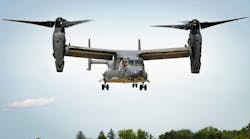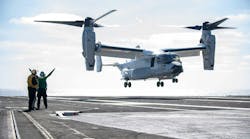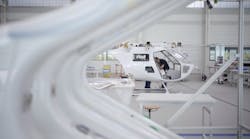By Shawn Coyle
The following is a brief excerpt from the book "Cyclic and Collective"
by Shawn Coyle. It is taken from the chapter discussing turbine engines on helicopters.
Turbine engines are different!
Turbine engines are different from piston engines in many ways, some obvious, others not so obvious. Turbine engines are:
- Smoother, with less noticeable vibration
- Quiter (or at least different noise, and certainly less exhaust noise)
- Lighter weight for the same horsepower (i.e. better power/weight ratio)
- More reliable (typically)
- Overhauled at greater intervals (hours)
- Easier to start in the cold
- Require less maintenance between overhauls
- Consume less engine oil
On the other hand, turbine engines also are:
- More expensive to purchase and overhaul
- Thirstier (they consume more fuel)
- Less tolerant to abuse
- More surprising when they fail (being quiter, they give less warning of failure)
A turbine engine typically does not have the ignition system on all the time. Some machines call out for ignition on during approach and landing, in order to help keep the engine runnig in the event it flames out.
In the free turbine engine, there is no direct mechanical connection between the power turbine and the compressor turbine - that is, there is no set of gears connecting them, only a gas path.
Terms relating to turbine engines
Many of the terms used in turbine engines have no industry agreed standard, resulting in confusion, even with the international standards mentioned
before. A typical example of this it TOT, TIT, ITT, T4, T5, even T4.5 - all represent the exhaust gas temperature somewhere in the engine. The reason for the different names is the diferent places the temperature is measured. For consistency the abbreviations used here will be:
N1: Compressor speed
N2: Power turbine speed
TOT: Turbine outlet temperature
Q: Torque
Most engine and rotor speeds are expressed in percent RPM to simplify the pilot's life. (Just think of the problem if the limits weren't in percent. Compressor speed limits might be 25,675 RPM for continuous use and 27,450 for takeoff. With percentage figures, you only have to memorize three digits at the most.)
A small point here about the terms N2 and NR. They are often confused, especially when talking about governors. Since the two are mechanically connected, they normally are considered equivalent. It is only when the helicopter is in autorotation, or in a strange situation for twin engine helicoters that they are not mechanically connected (in these cases, the NR will be higher than the N2).
This is also a good point to mention that it's not possible to compare temperature or RPM limits between engines. The temperatures might be measured at different points in the engines.
Difference between ratings and limitations
A rating is the power the engine will develop when it is run at the limiting speed at ISA standard day conditions. Limitations are those prescribed limits put on the engine by the manufacturer to permit continued operation and longer life.
Occasionally, a torque limitation will appear that (coincidently) equals the rating of the engine. Most limitations are designed with normal use in mind, and err on the side of safety, with some provision made for inadvertent excursions beyond this level. How much that margin is will remain a secret, so it is best not to exceed the normal limits, as you don't want to find out you were the one to go just beyond what the manufacturer had built in for careless pilots!
How long is each limit good for?
More than once I have heard that if there is a time limit on an engine rating, then if the rating has been used for that time, an equivalent
time must be spent below the limit. For example, if there is a 30 minute TOT limit, and the engine has been run to this TOT limit for 30 minutes, then, according to some, it is understood the engine must be kept out of that time limited rating for 30 minutes before it can be used again.
This is nonsense, for the following reasons. Firstly, if that's what is meant, it certainly isn't spelled out in any manual, airframe or engine or certification guidance I've ever seen. If that's what's implied, it should be spelled out. Second, and most importantly, I've checked with a few engine and airframe manufacturers and they all say that isn't the case.
Another false way of looking at this is to think that if something is damaged by overstressing, it can be made OK by under stressing it - this doesn't work.
Cycles
A problem of turbine engines is thermal stress and shock. It is not hard to understand that taking a piece of metal from a cool rest and suddenly heating it to 700 C while rotating it at high speeds is pretty hard on the metal. Do it enough times, and the resulting damage accumulates and the metal fails. For this reason, most turbine engines count cycles - the number of times the engine has been started and used at takeoff power. Change the temperature and RPM quickly or a lot, and the cycles also add up. This is why most large jet engines have such long lives - cruising at high altitude for long times, they have few cycles, and lots of time at one power setting. Helicopter engines unfortunately have lots of changes in power, (read changes in RPM and temperature) and hence relatively short (but glorious) lives.
Cycle counters can range from dumb things which only count the number of times the start button has been pressed, to devices which monitor the number of times TOT exceeds certain values while the N1 is above a certain RPM, or the number of times the collective has been raised while there is transmission oil pressure above a certain value. Pay attention to cycles if you have 'em. They will tell the story of abuse or tender loving care on the engine.
Measuring temperature
It's not easy to accurately measure temperatures deep within the inferno
of the engine, and as accurate as the cockpit indications are, they are really only approximate. The temperature indicated is really only a guess at what is happening to the metal, and it is for this reason that there are transient limits of temperature, particularly for starting. The real problem is that the metal can't stand high temperatures for prolonged periods, and the short period allowed for a high temperature during starting (or sometimes during operation) means that this high temperature won't exist long enough to affect the turbine blades.
Density altitude vs. pressure altitude and OAT
One of the major differences between piston and turbine engines is the effect of atmospheric conditions on power available. In simple terms, the power available from a piston engine depends upon density altitude, whereas the power available from a turbine engine depends upon pressure altitude and temperature.
Confused? I can hear the questions from here. Yes - pressure altitude and air temperature do make a density altitude, but a density altitude can be made from a wide variety of pressure altitudes and temperatures.
An example is a 5,000-foot density altitude. It could be 9,000-foot pressure altitude at -40 C, or 1,800-foot pressure altitude at 40 C, or 5,000-foot pressure altitude at 5 C. However, 9,000-foot pressure altitude and -40 C will always be 5,000-foot density altitude (at least close enough for the purposes of demonstration).
Most helicopter pilots operating from the same location see only the effect of the air temperature, as altimeter setting changes won't make much difference to pressure altitude (at least not as far as engine power is concerned). They know they have less power available on hotter days, or the TOT is higher on a hot day than on a cold day for the same torque used. The natural tendency is to blame the change on density altitude.
It is not correct to say power available for the turbine engine depends on density altitude.
This has been a brief excerpt from the book Cyclic & Collective discussing helicopter turbine engines. Cyclic & Collective is a resource on helicopter systems. It is an interesting read for mechanics and pilots alike, especially helping those not familiar with helicopters gain a further understanding of these aircraft. For more information, you can go to www.helobooks.com.





